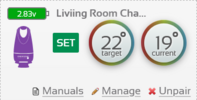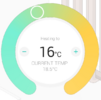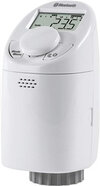Hello,
During recent renovation works I have installed a single gang pattress box in most rooms near the light switches with provision for wiring cat5 / 8 Core Alarm cable back to the airing cupboard / boiler control area. I am also putting in provision for getting 4 core alarm cable to each radiator. The idea being to install 24v thermal actuator heads on each rad valve and for each room to have a temp sensor / controller of sorts which signals back to a main controller and probably an attached embedded PC. This would then run a per-room schedule with influence from outside temp, flow and return temps from boiler / aggregate temp demands, weather forecast and time etc. Ideally with a local web server / page overview that would then be accessable on PCs in the house.
Goals being to have no part of the system wireless and for any computer software on the embedded PC to be open source (e.g. OpenHAB).
My ponderance is if there is any COTS systems that would work for the room control panels or central controller?
Ideally something with a display of current and target temp with ability to request boost / temporary override. This should then pull the target temp from the central system.I will (eventually) cook something up as a longer term DIY project if it does not exist but most openHAB stuff seems to have been done by the software engineering fraternity so hardware wise seems to mainly be lots of IoT and bluetooth / wireless widgits or COTS devices. I like the idea of a dedicated wall plate for interfacing with the system, rather than battery wireless sensors.
At the very least as an early revision, a wall box could just be a temp sensor and a push button with some feedback LEDs for if the room is being heated / overridden etc (so entirely passive)...
Is there any prior work or projects that anyone knows of in this area?
During recent renovation works I have installed a single gang pattress box in most rooms near the light switches with provision for wiring cat5 / 8 Core Alarm cable back to the airing cupboard / boiler control area. I am also putting in provision for getting 4 core alarm cable to each radiator. The idea being to install 24v thermal actuator heads on each rad valve and for each room to have a temp sensor / controller of sorts which signals back to a main controller and probably an attached embedded PC. This would then run a per-room schedule with influence from outside temp, flow and return temps from boiler / aggregate temp demands, weather forecast and time etc. Ideally with a local web server / page overview that would then be accessable on PCs in the house.
Goals being to have no part of the system wireless and for any computer software on the embedded PC to be open source (e.g. OpenHAB).
My ponderance is if there is any COTS systems that would work for the room control panels or central controller?
Ideally something with a display of current and target temp with ability to request boost / temporary override. This should then pull the target temp from the central system.I will (eventually) cook something up as a longer term DIY project if it does not exist but most openHAB stuff seems to have been done by the software engineering fraternity so hardware wise seems to mainly be lots of IoT and bluetooth / wireless widgits or COTS devices. I like the idea of a dedicated wall plate for interfacing with the system, rather than battery wireless sensors.
At the very least as an early revision, a wall box could just be a temp sensor and a push button with some feedback LEDs for if the room is being heated / overridden etc (so entirely passive)...
Is there any prior work or projects that anyone knows of in this area?








